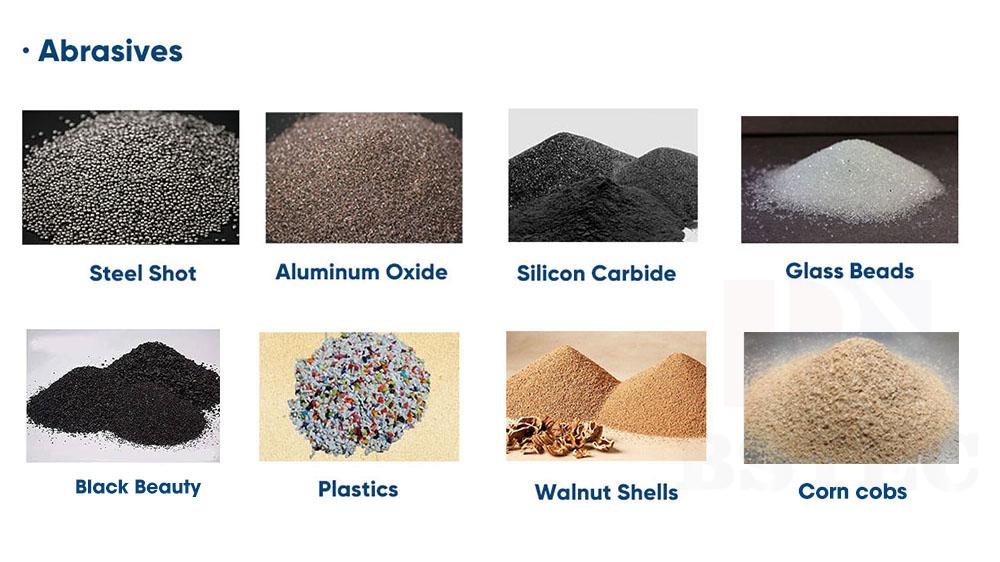Basics Selecting Components of Sandblasting
Basics Selecting Components of Sandblasting

Sand was the most common abrasive used in this process, hence the name sandblasting. In the last 50 years, additional materials have been adapted for the process of cleaning materials.
Today, the terms media blasting and abrasive blast cleaning more accurately define the process, since blast material can include any number of products, such as coal slag, garnet, glass beads, walnut shells, and corncobs.
Media blasting can be used on virtually every part of the tractor, given the right mix of media material, air pressure, volume, and blast nozzle.
Following are some of the basics when it comes to selecting components.
The Compressor
The air compressor is the most important component of the sandblasting process. It provides the air volume and pressure to move the abrasive media though the hose and blast nozzle with enough velocity to remove scale, rust, or aged coatings from the target surface.
For cabinet blasting, 3 to 5 cubic feet per minute (cfm) may be adequate, he says. For larger jobs, a range of 25 to 250 cfm may be necessary.
When choosing a blast pot or cabinet, there are two types to choose from: suction feed and pressure feed.
Feed Systems
Suction-feed systems operate by siphoning abrasives directly into the blast gun. This relies on compressor air being fed into the blast gun to create a vacuum. When the gun is triggered, the abrasive is sucked into the feed line to the blast gun. The escaping air then carries the abrasive to the target surface.
In contrast, pressure-feed systems store the abrasive in a vessel or pot. The pot operates at a pressure equal to that of the material hose. A control valve positioned at the bottom of the pot meters the abrasive into a high-velocity air stream. The air stream then carries the abrasive through the blast hose to the work surface.
The blast nozzle is the device that's used to maximize the impact speed of the sandblasting abrasive. While there are several different types of nozzles, there are four common ones.
* A straight-bore nozzle creates a tight pattern for spot cleaning or cabinet blasting. It is usually used for cleaning small parts.
* A venturi nozzle is the best choice for high-production cleaning of large surfaces. It's important to note, however, that when blasting at high pressures (100 psi or more), abrasives can reach speeds of over 500 mph.
* A double-venturi blast nozzle can be thought of as two nozzles placed end to end. Air-induction holes in the body of the nozzle allow compressor air to mix with atmospheric air. This venturi action increases cfm and also increases the size of the blast pattern. Deardorff notes that a double-venturi nozzle is the best choice for low-pressure cleaning. This is because the suction action of the air-induction holes has the ability to carry large amounts of heavy, dense abrasives through the material hose at low pressure.
* A fan nozzle produces a fan pattern that is used to blast large, flat surfaces. The fan nozzle requires more cfm air volume for operation.
Nozzles are also available with a choice of lining materials, which include aluminum, tungsten carbide, silicon carbide, and boron carbide. Naturally, the choice depends on your budget and the rigors of the job. Just keep in mind that media consumption increases with nozzle wear.
All About Abrasives
Factors that affect abrasive performance include the following.
* Toughness of grime, corrosion, or aged coatings to be removed.
* Surface composition and sensitivity.
* The quality of cleaning required.
* The type of abrasive.
* Cost and disposal costs.
* Recycle potential.
The abrasive is the part of any blasting process that actually does the cleaning work. There are four major classifications for abrasive materials.
* Natural abrasives include silica sand, mineral sands, garnet, and specular hematite. These are considered expendable abrasives and are mainly used for outdoor blasting.
* Man-made or manufactured abrasives, such as glass beads, aluminum oxide, silicon carbide, steel shot, and plastic media, are reusable and can be used in systems that allow recovery and recycling.
* By-product abrasives – such as coal slag, which is a by-product of coal-fired electric power plants – are considered the most widely used abrasive after silica sand.
* Non-metallic abrasives are usually classified as organic materials. These include glass beads, plastic media, and grain types such as corncobs, wheat starch, pecan shells, coconut shells, and walnut shells. Organic abrasives are used when minimal surface damage is required.

Shape and Hardness
Other considerations when choosing an abrasive are physical shape and hardness.
"The shape of the abrasive will determine the quality and speed for the blasting process," Deardorff notes. "Angular, sharp, or irregular-shape abrasives will clean faster and etch the target surface. Round or spherical abrasives will clean parts without removing excessive amounts of the base material."
The hardness, meanwhile, affects not only the speed at which it cleans, but also the amount of dust produced and the breakdown rate, which also has a direct effect on recycle potential.
The hardness of an abrasive is classified by a Mohs rating – the higher the number from 1 (talc) to 10 (diamond), the harder the product.
If you are interested in Abrasive Blast Nozzle and want more information and details, you can CONTACT US by phone or mail at the left, or SEND US MAIL at the bottom of the page.













